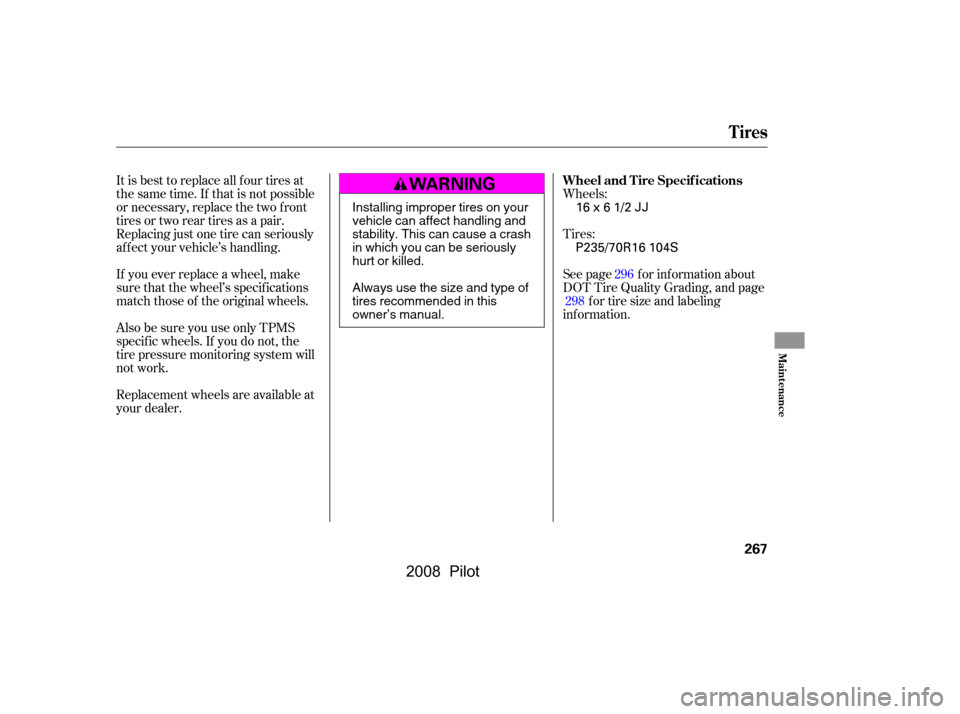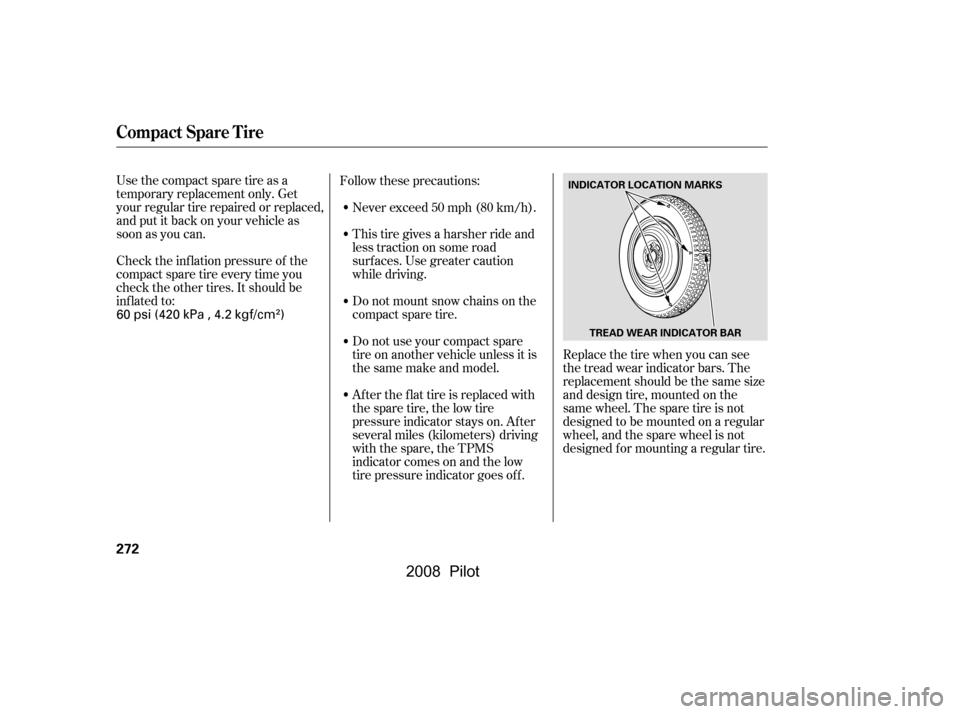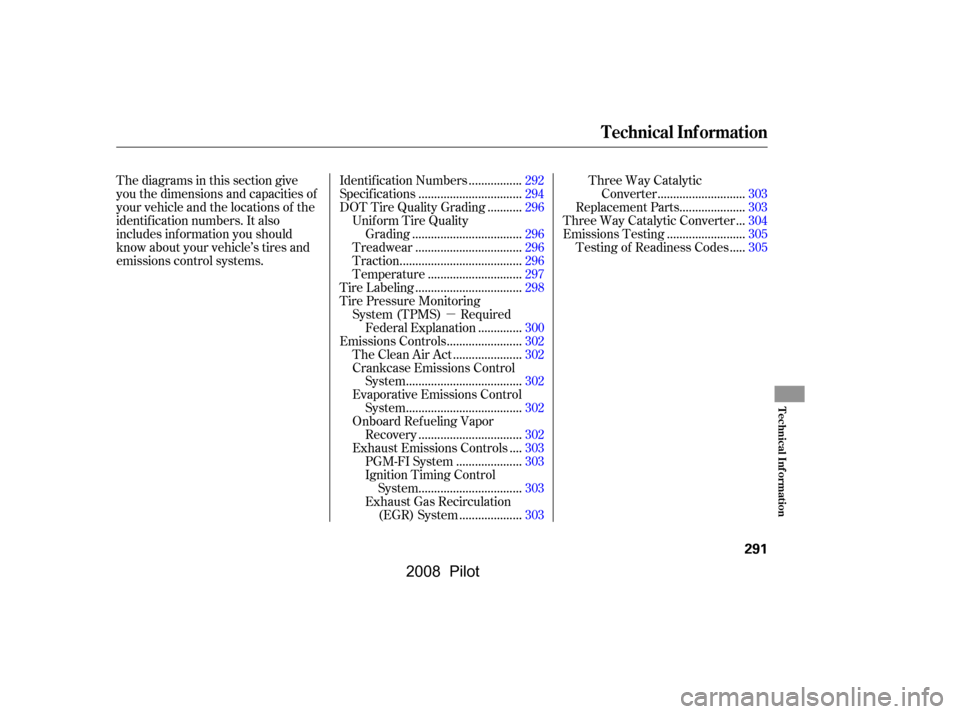Page 268 of 329

The following chart shows the
recommended cold tire pressures f or
most normal driving conditions.
Thecompactsparetirepressureis:
For convenience, the recommended
tire sizes and cold tire pressures are
on a label on the driver’s doorjamb.
For additional inf ormation about
your tires, see page .
If you check air pressures when the
tires are hot [driven f or several miles
(kilometers)], you will see readings 4
to6psi(30to40kPa,0.3to0.4
kgf /cm ) higher than the cold
readings. This is normal. Do not let
air out to match the recommended
cold air pressure. The tire will be
underinf lated.
Youshouldgetyourowntire
pressure gauge and use it whenever
you check your tire pressures. This
will make it easier f or you to tell if a
pressure loss is due to a tire problem
and not due to a variation between
gauges.
While tubeless tires have some
ability to self -seal if they are
punctured, you should look closely
for punctures if a tire starts losing
pressure.
Even though your vehicle is
equipped with TPMS, we
recommend that you visually check
your tires every day. If you think a
tire might be low, check it
immediately with a tire gauge.
Use a gauge to measure the air
pressure in each tire at least once a
month. Even tires that are in good
condition may lose 1 to 2 psi (10 to
20 kPa, 0.1 to 0.2 kgf /cm ) per
month. Remember to check the
sparetireatthesametime.
Check the air pressures when the
tires are cold. This means the
vehicle has been parked f or at least 3
hours, or driven less than 1 mile (1.6
km). Add or release air, if needed, to
match the recommended cold tire
pressures.
295
Tire Size Cold Tire Pressure
for Normal Driving
Tires
Recommended T ire Pressures
264
60 psi (420 kPa , 4.2 kgf/cm)
32 psi (220 kPa ,2.2 kgf/cm
)
P235/70R16 104S
�\f���—�\f���—�\f���y�
�
�������\f���y���
�(���+�����\f�y�\f�������y
2008 Pilot
Page 271 of 329

It is best to replace all f our tires at
thesametime.If thatisnotpossible
or necessary, replace the two f ront
tires or two rear tires as a pair.
Replacing just one tire can seriously
af f ect your vehicle’s handling.
If you ever replace a wheel, make
sure that the wheel’s specif ications
match those of the original wheels.Wheels:
Tires:
See page f or inf ormation about
DOT Tire Quality Grading, and page
f or tire size and labeling
inf ormation.
Also be sure you use only TPMS
specif ic wheels. If you do not, the
tire pressure monitoring system will
not work.
Replacement wheels are available at
your dealer. 296
298
Wheel and T ire Specif ications
Tires
Maint enance
267
16x61/2JJ
P235/70R16 104S
Installing improper tires on your
vehicle can affect handling and
stability. This can cause a crash
in which you can be seriously
hurt or killed.
Always use the size and type of
tires recommended in this
owner’s manual.
�\f���—�\f���—�\f���y�
�
�����������y���
�(���+�����\f�y�\f�������y
2008 Pilot
Page 276 of 329

Use the compact spare tire as a
temporary replacement only. Get
your regular tire repaired or replaced,
and put it back on your vehicle as
soon as you can.
Check the inf lation pressure of the
compact spare tire every time you
check the other tires. It should be
inf lated to:Replace the tire when you can see
the tread wear indicator bars. The
replacement should be the same size
and design tire, mounted on the
same wheel. The spare tire is not
designed to be mounted on a regular
wheel, and the spare wheel is not
designed f or mounting a regular tire.
Follow these precautions:
Never exceed 50 mph (80 km/h).
This tire gives a harsher ride and
less traction on some road
surf aces. Use greater caution
while driving.
Do not mount snow chains on the
compact spare tire.
Do not use your compact spare
tire on another vehicle unless it is
thesamemakeandmodel.
After the flat tire is replaced with
the spare tire, the low tire
pressure indicator stays on. Af ter
several miles (kilometers) driving
with the spare, the TPMS
indicator comes on and the low
tire pressure indicator goes of f .
Compact Spare Tire
272
TREAD WEAR INDICATOR BAR
INDICATOR LOCATION MARKS
60 psi (420 kPa , 4.2 kgf/cm)
�\f���—�\f���—�
�\f�y�
���������
���y���
�(���+�����\f�y�\f�������y
2008 Pilot
Page 280 of 329
Insert the hoist bracket into the
center hole of the f lat tire.
Slowly turn the wheel nut wrench
clockwisetotakeuptheslackof
the hoist cable. Make sure the
bracketisseatedinthecenter
hole of the f lat tire.Turn the wheel nut wrench
clockwise until the f lat tire rests
against the underbody of the
vehicle and you hear the hoist
click.
Store the jack in its holder. Turn
the jack’s end bracket to lock it in
place. Replace the cover. Store the
tools.
Refer to
(see page ).
17.
18. 19.
20. 21. 213
Changing a Flat Tire
Changing a T ire with
TPMS
276
WHEEL NUT WRENCH
Loose items can fly around the
interiorinacrashandcould
seriously injure the occupants.
Store the wheel, jack, and tools
securely before driving.
Always raise the spare tire hoist, even
if you are not stowing a tire. If the
hoist is lef t down, it will be damaged
during driving and need to be replaced.
�\f���—�\f���—�\f���y�
�
����\f������y���
�(���+�����\f�y�\f�����
�y
2008 Pilot
Page 293 of 329
�µ�µ
No. Amps. No. Circuits Protected
No. Circuits ProtectedAmps.
Amps.
Circuits Protected
Circuits Protected
No. Amps.
CONT INUED
1
2
3
4
5
6
7
8
9
10
11
12
13 20 A
30 A
20 A
15 A
15 A
20 A
20 A
20 A
40 A
40 A
30 A
40 A 14
15
16
17
18
19
20
21
22
23
24
Rear A/C
Heater Motor
Cooling Fan
Spare Fuse
Spare Fuse
Spare Fuse
Battery
Condenser Fan
MG Clutch
IGI Main
Trailer (accessory)
7
8
9
10
11 ET CS
IG Coil
LAF
TPMS
(FR FOG)
30 A
40 A
30 A
7.5 A 10 A
15 A
120 A 30 A
7.5 A 50 A
15 A
15 A
15 A
7.5 A
(20 A)
Spare Fuse
Spare Fuse
Right Headlight
ACG S
Hazard
Not used
Stop, Horn
Left Headlight
Radio
Power Window Motor
Power Seat
Rear Defroster
Back Up, ACC
AC INVERTER
VSA F/S Relay
VSA Motor
VTM-4
ACM
Rear Accessory Socket
1
2
3
4
5
6 20 A
40 A
30 A
20 A
10 A
15 A
Fuse Locations
T aking Care of t he Unexpect ed
289
PRIMARY UNDER-HOOD FUSE BOX
SECONDARY UNDER-HOOD FUSE BOX
�\f���—�\f���—�\f���y�
�
���������
�y���
�(���+�����\f�y�\f�������y
2008 Pilot
Page 295 of 329

�µ
Thediagramsinthissectiongive
you the dimensions and capacities of
your vehicle and the locations of the
identif ication numbers. It also
includes inf ormation you should
know about your vehicle’s tires and
emissions control systems.
................
Identif ication Numbers .292
................................
Specif ications .294
..........
DOT Tire Quality Grading .296
Unif orm Tire Quality ..................................
Grading .296
.................................
Treadwear .296
......................................
Traction .296
.............................
Temperature .297
.................................
Tire Labeling .298
Tire Pressure Monitoring
System (TPMS) Required .............
Federal Explanation .300
.......................
Emissions Controls .302
.....................
The Clean Air Act .302
Crankcase Emissions Control
....................................
System .302
Evaporative Emissions Control ....................................
System .302
Onboard Ref ueling Vapor ................................
Recovery .302
...
Exhaust Emissions Controls .303
....................
PGM-FI System .303
Ignition Timing Control
................................
System .303
Exhaust Gas Recirculation ...................
(EGR) System .303 Three Way Catalytic
...........................
Converter .303
....................
Replacement Parts .303
..
Three Way Catalytic Converter .304
........................
Emissions Testing .305
....
Testing of Readiness Codes .305
T echnical Inf ormation
Technical Inf ormation
291
�\f���—�\f���—�\f���y�
�
�����������y���
�(���+�����\f�y�\f�������y
2008 Pilot
Page 304 of 329

�µ
Each tire, including the spare (if
provided), should be checked
monthly when cold and inf lated to
the inf lation pressure recommended
by the vehicle manuf acturer on the
vehicle placard or tire inf lation
pressure label.
(If your vehicle has tires of a
dif f erent size than the size indicated
on the vehicle placard or tire
inf lation pressure label, you should
determine the proper tire inf lation
pressure f or those tires.)Accordingly, when the low tire
pressure telltale illuminates, you
should stop and check your tires as
soon as possible, and inf late them to
the proper pressure.Driving on a signif icantly under-
inf lated tire causes the tire to
overheat and can lead to tire failure.
Under-inf lation also reduces f uel
efficiency and tire tread life, and may
af f ect the vehicle’s handling and
stopping ability.
Please note that the TPMS is not a
substitute for proper tire
maintenance, and it is the driver’s
responsibility to maintain correct tire
pressure, even if under-inf lation has
not reached the level to trigger
illumination of the TPMS low tire
pressure telltale.
As an added safety feature, your
vehicle has been equipped with a tire
pressure monitoring system (TPMS)
that illuminates a low tire pressure
telltale
and/or
when one or more of your tires is
signif icantly under-inf lated.
Tire Pressure Monitoring System (TPMS) Required Federal Explanation
300
�\f���—�\f���—�\f���y�
�
�����������y���
�(���+�����\f�y�\f���\f���y
2008 Pilot
Page 305 of 329
�µ
Always check the TPMS malf unction
telltale af ter replacing one or more
tires or wheels on your vehicle to
ensure that the replacement or
alternate tires and wheels allow the
TPMS to continue to f unction
properly.
Your vehicle has also been equipped
with a TPMS malf unction indicator
to indicate when the system is not
operating properly. The TPMS
malf unction indicator is provided by
a separate telltale, which displays the
symbol ‘‘TPMS’’ when illuminated.
When the malf unction indicator is
illuminated,
the system may not be able to detect
or signal low tire pressure as
intended.
TPMS malf unctions may occur f or a
variety of reasons, including the
installation of replacement or
alternate tires or wheels on the
vehicle that prevent the TPMS f rom
f unctioning properly.
Tire Pressure Monitoring System (TPMS) Required Federal Explanation
Technical Inf ormation
301
�\f���—�\f���—�\f���y�
�
�����������y���
�(���+�����\f�y�\f���\f���y
2008 Pilot